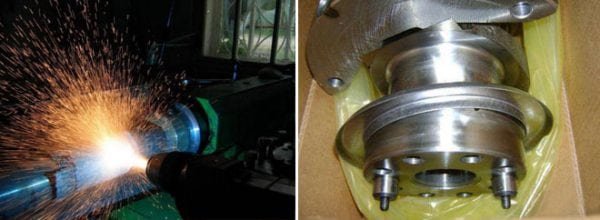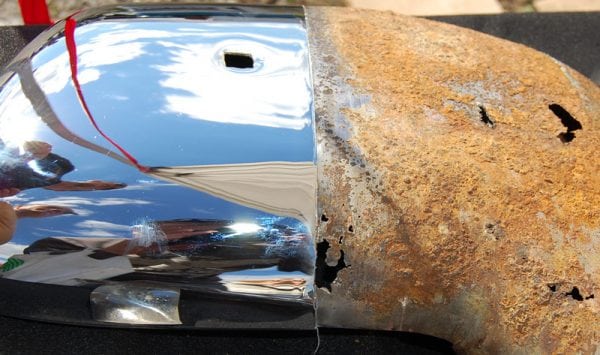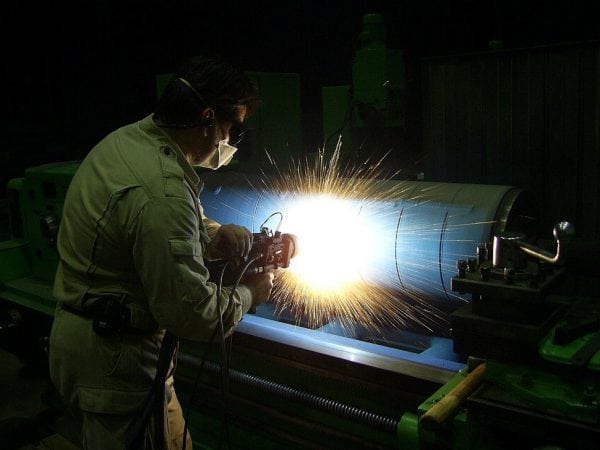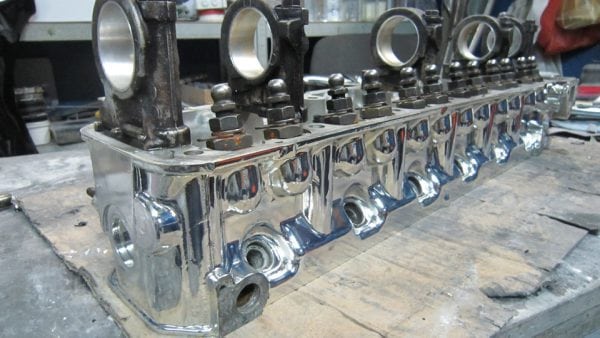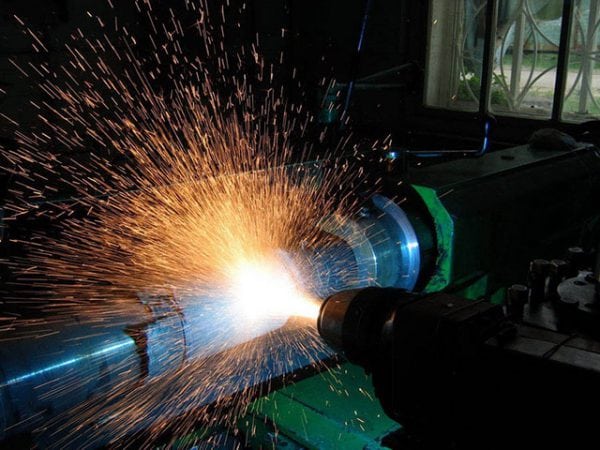Metallization is an effective way to give the final product additional technical and operational characteristics. Plasma spraying is a perfect diffuse treatment of metal surfaces to create a high-quality coating of another metal or alloy. Diffuse metallization improves hardness, strength, color and anticorrosive properties of the original part.
- Distinctive features of diffuse spraying
- Diffuse Equipment
- Where to use plasma metallization
- Plasma metallization options
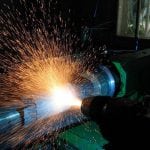
Distinctive features of diffuse spraying
When working with metal surfaces, it is often necessary to give the final product additional characteristics in order to expand the scope of the part. You can protect the metal surface from moisture, high temperature and aggressive chemical environment. Plasma spraying has a number of features that distinguish the metallization process from other options for processing metal surfaces:
- The accelerated coating process due to the high-temperature effect on the treated surface is about 5000-6000 ° C. Technologically, the spraying can last a fraction of a second to obtain the desired result.
- Plasma processing of metals allows you to create a combined layer on the surface. It is possible to diffuse not only metal particles, but also elements of gas from a plasma jet. As a result, the metal is saturated with atoms of the necessary chemical elements.
- Traditional metallization is uneven and is characterized by the duration of the process and possible oxidative reactions. A jet of high-temperature plasma creates uniform temperature and pressure, providing high quality final coatings.
- Using a plasma jet, the transfer of metal particles and gas atoms occurs instantly. The process relates to the field of welding using powders, rods, rods and wire. The transferred particles form a layer with a thickness of a few microns to millimeters on the surface of a solid.
to contents ↑Modern diffuse metallization involves the use of more complex equipment than in cases where gas-plasma equipment is used. To organize the process of diffuse processing requires the simultaneous presence of gas and electrical equipment.
Diffuse Equipment
Ion-plasma sputtering over the surface of metals is carried out using high-temperature technical plasma - a combination of a large number of particles (light quanta, positive ions, neutral particles, electron gas). Under the influence of high temperature due to electric discharges in gases, intense thermal ionization of particles occurs that are difficult to interact with each other and the environment. Due to this, a plasma is distinguished that is weakly, moderately and strongly ionized, which, in turn, can be low-temperature and high-temperature.
To create the necessary conditions for the process of plasma ionization and processing of metal coatings helps special equipment - plasma systems. Usually, arc, pulsed or spark electric discharges are used for work.
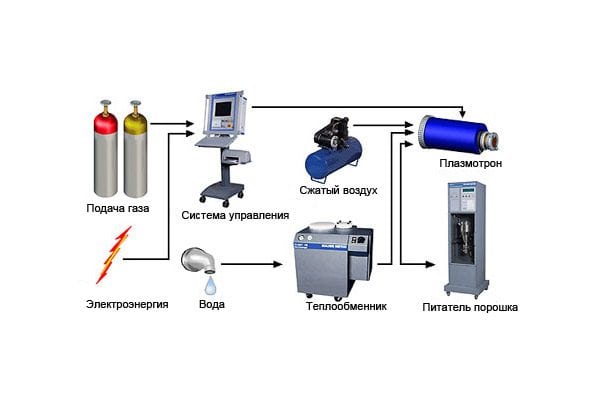
For the implementation of the process requires the following settings:
- High-frequency type generator (you can use a welding transducer) - serves as a source of discharge.
- A sealed chamber in which plasma spraying parts are placed.
- Gas tank. In its atmosphere, the ionization of particles under the influence of an electric discharge.
- Gas pressure generating unit. You can use a vacuum or pumping equipment.
- A system with which you can qualitatively change the current characteristics, pressure, voltage, thereby increasing or decreasing the thickness of the sprayed coatings.
How plasma spraying occurs: the workpiece is fixed in a sealed chamber, an electric discharge is created, a working medium is pumped with the necessary pressure and sprayed powder elements. A high-temperature plasma is formed, which transfers the powder particles together with gas atoms to the surface of some part. When carrying out diffuse metallization in a vacuum, in an inert gas atmosphere or under reduced pressure, it is possible to increase the particle velocity and obtain a more dense and highly adhesive type of coating.
to contents ↑Where to use plasma metallization
Since practically any alloy or metal can serve as a sprayed material, ion-plasma spraying is widely used in various industries, as well as for repair and restoration work. Any metal in the form of powders is fed into a plasma system, where, under the influence of a high-temperature plasma, it melts and penetrates into the metal surface being treated in the form of a thin spraying layer. Scopes of diffuse metallization:
- parts for the aviation, space and rocket industry;
- machine-building equipment and energy industry;
- metallurgical and chemical industries;
- oil production, oil refining and coal industry;
- transport and instrumentation;
- repair and restoration of machinery, equipment, worn parts.
When a jet of plasma and powders passes through an electric arc and is deposited on the treated surface, the formed layer acquires important qualitative and operational characteristics:
- heat resistance;
- heat resistance;
- corrosion resistance;
- electrical insulation;
- thermal insulation;
- erosive strength;
- cavitation protection;
- magnetic characteristics;
- semiconductor properties.
to contents ↑The input of sprayed powders into the plants is carried out with a plasma-forming or transported gas. Plasma spraying allows you to get various types of coatings without limitation on the melting temperature: metals, combined alloys, carbides, oxides, borides, nitrides, composite. The material that is processed in the plants does not undergo structural changes, but the surface of the product acquires the necessary quality characteristics. You can spray combined layers (soft and hard), refractory coatings, and compositions with different densities.
Plasma metallization options
For applying a certain spraying layer to a metal surface in a high-temperature plasma environment, not only powder formulations are used as forming coatings. Depending on what properties the treated surface should have, the following features of plasma metallization are used:
- Deposition by high-carbon or alloy wire submerged arc.For surface restoration, surfacing is used in installations with a rod or plate electrode.
- Powder-coated surfacing under the flux is used to restore parts with extensive deformations around the circumference with a layer thickness of more than 2 mm.
- Plants for spraying pass argon, nitrogen, hydrogen, helium or mixtures thereof as plasma-forming gases. It is necessary to ensure the absence of oxygen in order to prevent oxidation of the deposited coatings.
Most often, this type of processing is used to restore various parts in the repair of automobile engines. So, using diffuse metallization, it is possible to restore the holes of the main bearings in the cylinder blocks (common breakdown), eliminate the wear of the cylinder heads, restore the pistons from aluminum alloy, crankshafts from ductile iron, rollers, rollers.
When using ion-plasma spraying, the wear resistance of complex components of equipment, mechanisms and installations significantly increases. Diffuse metallization is an effective method of restoring worn and tired metal, as well as the optimal process for setting the metal surfaces to the required strength and performance characteristics.

